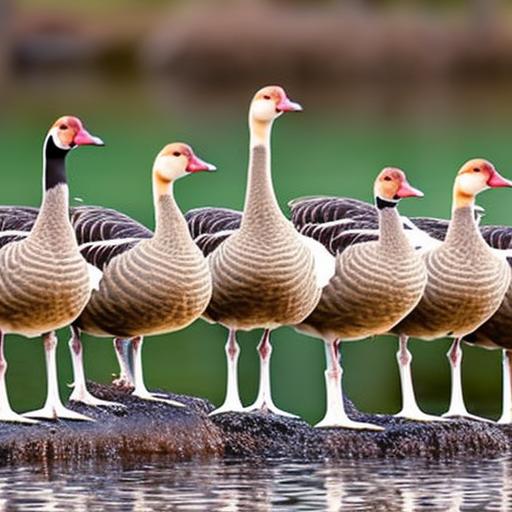Geese have been raised for meat for centuries, and their popularity as a meat source is on the rise. Geese are known for their flavorful and tender meat, making them a favorite among many chefs and food enthusiasts. In addition to their delicious taste, geese are also relatively easy to raise and require minimal maintenance compared to other livestock. This combination of factors has led to an increase in the number of people raising geese for meat.
Key Takeaways
- Geese are a popular meat bird that have been used as a food source for centuries.
- The top 5 breeds of geese for meat production are Embden, Toulouse, Pekin, African, and Chinese.
- Meat geese are characterized by their large size, fast growth rate, and high meat yield.
- Raising geese for meat has many benefits, including their hardiness, low maintenance, and ability to forage for food.
- Geese have a long history as a food source, dating back to ancient times and being a staple in many cultures around the world.
The Top 5 Breeds of Geese for Meat Production
1. Embden Geese: Embden geese are one of the most popular breeds for meat production. They are large birds with white feathers and orange bills and feet. Embden geese are known for their fast growth rate and high meat yield. They have a calm temperament, making them easy to handle and manage.
2. Toulouse Geese: Toulouse geese are another popular breed for meat production. They are large birds with gray feathers and blue eyes. Toulouse geese have a good meat-to-bone ratio, making them ideal for meat production. They are also known for their calm and docile nature.
3. Chinese Geese: Chinese geese are smaller in size compared to other meat breeds, but they make up for it with their excellent meat quality. They have a high percentage of breast meat, which is highly valued by chefs and consumers alike. Chinese geese are also known for their alert and active nature.
4. African Geese: African geese are large birds with gray feathers and pink bills and feet. They have a good meat yield and are known for their flavorful meat. African geese are also excellent foragers, which can help reduce feed costs.
5. Pilgrim Geese: Pilgrim geese are a heritage breed that is gaining popularity for meat production. They have a good meat-to-bone ratio and are known for their tender and flavorful meat. Pilgrim geese are also known for their calm and friendly temperament.
Understanding the Characteristics of Meat Geese
Meat geese have certain characteristics that make them ideal for meat production. Unlike other types of geese, meat geese are bred specifically for their meat qualities. They have a fast growth rate, which means they reach market weight in a relatively short period of time. This makes them a cost-effective option for meat production.
Meat geese also have a high meat-to-bone ratio, which means they have a higher percentage of meat compared to other parts of their body. This is important for maximizing the yield of meat from each bird. In addition, meat geese have a good feed conversion ratio, which means they efficiently convert feed into meat.
The Benefits of Raising Geese for Meat
There are several benefits to raising geese for meat. First and foremost, goose meat is delicious and flavorful. It has a rich, succulent taste that is often compared to duck or beef. Goose meat is also tender and juicy, making it a favorite among chefs and food enthusiasts.
In addition to its taste, goose meat is also highly nutritious. It is a good source of protein, vitamins, and minerals. Goose meat is also lower in fat compared to other types of poultry, making it a healthier choice for those watching their fat intake.
Raising geese for meat also has environmental benefits. Geese are efficient grazers and can help control weeds and pests in pastures. They also produce high-quality manure, which can be used as fertilizer for crops.
The History of Geese as a Food Source
Geese have been raised for food for thousands of years. They were domesticated in ancient Egypt and were considered a delicacy by the ancient Greeks and Romans. In medieval Europe, geese were a common food source for peasants and were often served during festive occasions.
Traditionally, geese were raised on small farms and were allowed to graze freely on pasture. They were fed a diet of grass, grains, and kitchen scraps. Geese were typically slaughtered in the fall, before the winter months when feed was scarce.
How to Select and Purchase Meat Geese

When selecting meat geese, it is important to choose healthy birds that are free from any diseases or deformities. Look for birds that have bright eyes, clean feathers, and alert behavior. Avoid birds that appear lethargic or have any signs of illness.
There are several places where you can purchase meat geese. Local farms and hatcheries often sell geese for meat production. You can also find meat geese for sale online through various websites and forums. When purchasing meat geese, make sure to choose a reputable seller who has a good track record of providing healthy birds.
Housing and Feeding Requirements for Meat Geese
Meat geese require proper housing and feeding to ensure their health and well-being. They should be provided with a spacious and secure enclosure that protects them from predators and the elements. The enclosure should have access to fresh water for drinking and bathing.
Meat geese should be fed a balanced diet that includes a combination of grains, grass, and vegetables. They should also have access to fresh pasture for grazing. It is important to provide them with enough food to meet their nutritional needs, but not overfeed them as this can lead to health problems.
Raising and Caring for Meat Geese: Tips and Tricks
Raising meat geese can be a rewarding experience, but it does require some knowledge and effort. Here are some tips and tricks to help you raise healthy and happy meat geese:
– Provide plenty of space: Meat geese need plenty of space to move around and exercise. Make sure their enclosure is large enough to accommodate their size and allows them to graze and forage.
– Provide fresh water: Geese need access to fresh water for drinking and bathing. Make sure to provide them with clean water on a daily basis.
– Monitor their health: Regularly check your geese for any signs of illness or injury. If you notice any abnormalities, consult a veterinarian for proper diagnosis and treatment.
– Socialize your geese: Geese are social animals and thrive in the company of others. It is recommended to raise geese in pairs or small groups to prevent loneliness and boredom.
Harvesting and Butchering Meat Geese: Best Practices
When it comes time to harvest and butcher your meat geese, it is important to follow best practices to ensure the meat is safe and high-quality. Here are some tips:
– Choose the right time: Geese are typically harvested in the fall when they have reached market weight. This is usually around 16-20 weeks of age.
– Use humane methods: It is important to use humane methods when slaughtering geese. This includes minimizing stress and ensuring a quick and painless death.
– Properly store the meat: After butchering, it is important to properly store the meat to maintain its quality and safety. Keep the meat refrigerated or frozen until ready to use.
Delicious Recipes for Cooking and Serving Meat Geese
There are many delicious recipes for cooking and serving goose meat. Here are a few ideas:
– Roast Goose: Roasting a whole goose is a classic way to enjoy this flavorful meat. Season the goose with herbs and spices, then roast it in the oven until golden brown and crispy.
– Goose Confit: Confit is a traditional French method of cooking meat in its own fat. To make goose confit, slowly cook goose legs in goose fat until tender and flavorful.
– Goose Breast Stir-Fry: Slice goose breast into thin strips and stir-fry with vegetables and your favorite sauce for a quick and delicious meal.
Raising geese for meat is a rewarding and enjoyable experience. Geese are not only delicious to eat, but they also offer several health and environmental benefits. By selecting the right breed, providing proper care and nutrition, and following best practices for harvesting and butchering, you can enjoy the flavorful and tender meat of your own home-raised geese. So why not give it a try and experience the joys of raising and cooking your own goose meat?
If you’re interested in learning more about breeds of geese for meat, you might also find this article on Poultry Wizard helpful. It provides valuable information on how to choose the right breed of geese for meat production, including factors such as size, growth rate, and meat quality. Check it out here: Breeds of Geese for Meat.
FAQs
What are the best breeds of geese for meat production?
The best breeds of geese for meat production are the Embden, Toulouse, and Pekin geese.
What is the average weight of a mature meat goose?
The average weight of a mature meat goose is around 10-12 pounds.
How long does it take for a meat goose to reach maturity?
It takes around 16-20 weeks for a meat goose to reach maturity.
What is the average lifespan of a meat goose?
The average lifespan of a meat goose is around 10-15 years.
What is the ideal diet for meat geese?
The ideal diet for meat geese includes a balanced feed that is high in protein and low in fat. They also require access to fresh water and grass.
What is the best way to prepare meat goose?
The best way to prepare meat goose is to roast it in the oven or smoke it on a grill. It is important to cook it thoroughly to ensure it is safe to eat.
Meet Walter, the feathered-friend fanatic of Florida! Nestled in the sunshine state, Walter struts through life with his feathered companions, clucking his way to happiness. With a coop that’s fancier than a five-star hotel, he’s the Don Juan of the chicken world. When he’s not teaching his hens to do the cha-cha, you’ll find him in a heated debate with his prized rooster, Sir Clucks-a-Lot. Walter’s poultry passion is no yolk; he’s the sunny-side-up guy you never knew you needed in your flock of friends!







